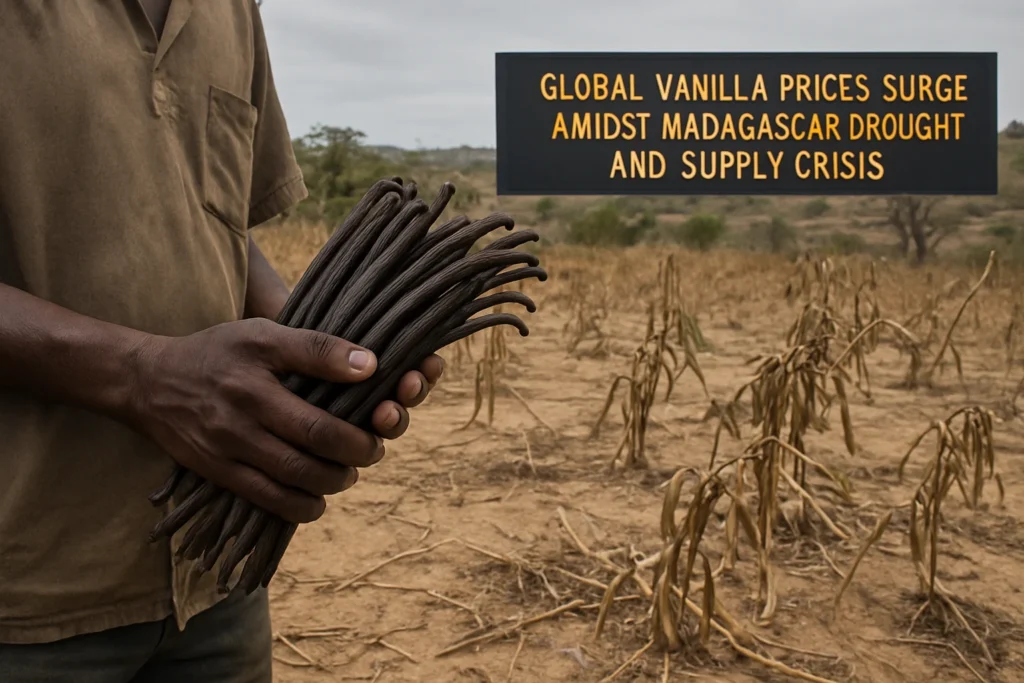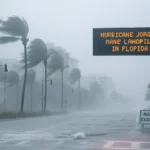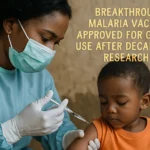Part 1: The Gathering Storm in the Sava Region
The Perfect Storm: A Confluence of Catastrophes
In the verdant embrace of Madagascar’s Sava region, where the air should be heavy with the sweet perfume of the vanilla orchid, a different story is being told. It is a tale of heat and hardship, of cracked earth and wilting vines, that is now sending shockwaves far beyond the shores of Madagascar, touching the ice cream parlors of Rome and the perfume ateliers of Paris. This agricultural heartland, responsible for a staggering 80% of the world’s premium vanilla, is grappling with a perfect storm of environmental, economic, and social crises.
Farmers like Jean-Baptiste Randrianarivo, a weathered man of 58 whose hands bear the scars of a lifetime spent tending to the delicate vines, watches helplessly as his family’s legacy withers. “This isn’t just a bad season,” he explains, his voice a mix of sorrow and resignation. “The rains have changed. The winds have changed. Even the bees have disappeared. We are losing everything we’ve built over generations.” Randrianarivo’s words are a somber testament to the converging factors that have created this unprecedented crisis:
- The Climate Cataclysm: For decades, Madagascar’s climate has been a model of stability, providing the consistent rainfall and humidity necessary for vanilla cultivation. Today, that stability is gone. The traditional rainy season has been shortened by an alarming six weeks over the past decade, and average temperatures have risen by 1.2°C since 1960. These changes have created an environment of unrelenting drought, baking the soil and stressing the delicate vanilla vines to their breaking point.
- The Soil’s Slow Death: The fertile soil of the Sava region, once a source of life and abundance, is now showing signs of exhaustion. Generations of intensive vanilla cultivation without proper crop rotation or sustainable farming practices have led to a critical decline in soil health. Nutrient levels in some areas have plummeted by 40% since the year 2000, leaving the vines without the vital sustenance they need to survive the harsh conditions.
- The Cycle of Economic Despair: The vanilla market has always been a turbulent one, characterized by dramatic boom-and-bust cycles. When prices are high, farmers are encouraged to invest more, often taking on debt. When prices inevitably crash, they are left with no safety net, trapped in a vicious cycle of poverty and desperation. This economic pressure leaves them ill-equipped to handle a crisis of this magnitude.
The Fragile Lifecycle: Why Vanilla is So Vulnerable
To truly understand the depth of the current crisis, one must appreciate the extraordinary and delicate nature of the vanilla lifecycle. Unlike most crops, vanilla’s journey from vine to flavor is a long and intricate dance between nature and human intervention, making it incredibly susceptible to disruption at any stage.
- The Unique Growth Requirements: The vanilla orchid (Vanilla planifolia) is a demanding plant. It thrives in specific conditions, requiring a delicate balance of filtered sunlight, high humidity, and a trellis or support tree to climb. It is not a plant that can easily adapt to a rapidly changing environment.
- The Moment of Hand-Pollination: This is perhaps the most famous and fragile stage of the process. Each vanilla blossom has a single day to live, and within a narrow 12-hour window, it must be hand-pollinated by a skilled worker. It is a meticulous, labor-intensive process, with a single person capable of pollinating 1,000-1,500 flowers a day. A lack of blossoms, or a lack of workers to perform this delicate task, can wipe out an entire season’s crop.
- The Long and Meticulous Curing Process: After harvest, the green beans are not yet vanilla. They undergo a months-long curing process that is as much an art as a science. This process involves blanching the beans in hot water, “sweating” them in blankets to ferment, and then a long period of sun-drying and conditioning to develop the signature aroma. Any disruption during this stage, from theft to improper handling, can destroy the final product.
Part 2: The Human and Economic Cost
The “Green Gold” Rush and Its Consequences
The soaring prices driven by the supply crisis have transformed vanilla into a commodity of such value that it is now referred to as “green gold.” This newfound wealth has not been a blessing for the farmers but a curse, attracting criminal networks and fueling a brutal cycle of violence.
- The Shadow of Armed Theft: Remote vanilla-growing regions are now patrolled by armed gangs who steal vanilla at gunpoint. In a desperate attempt to protect their only source of income, farmers have been forced to sleep in their fields, armed with machetes and makeshift weapons, risking their lives to guard their crops.
- The Toll of Violence: The human cost of this crisis is staggering. In 2024 alone, Madagascan authorities reported over 120 violent incidents related to vanilla theft, a figure that includes multiple fatalities. This violence has created a climate of fear and instability that makes an already difficult job even more perilous.
- The Scourge of Premature Harvesting: Fear of theft has led to a widespread and destructive practice: premature harvesting. Farmers, desperate to secure at least some of their crop before it can be stolen, are picking beans up to two months before they are ripe. This practice severely compromises the quality and flavor of the vanilla, flooding the market with substandard beans that still command a high price.
The Middleman Problem: A Broken Supply Chain
While farmers struggle on the front lines, a complex and often exploitative network of intermediaries profits handsomely from the trade. The vanilla supply chain is a multi-layered system that systematically extracts value at every turn, leaving the producers with a pittance.
- Local Collectors: These individuals buy vanilla directly from farmers, often at rock-bottom prices.
- Regional Consolidators: They aggregate the beans from multiple local collectors, adding their own markup.
- Export Agents: They handle the complex logistics of international shipments.
- Global Distributors: They are the final link, supplying the vanilla to major food and fragrance companies.
At each of these stages, markups of 100-300% are common, creating a vast disparity where farmers receive less than 10% of the final retail price. This broken system leaves the very people who produce the world’s vanilla with little to show for their dangerous and demanding work.
Part 3: The Global Fallout
The Food Sector’s Identity Crisis
The vanilla shortage is forcing a dramatic re-evaluation of product formulations and brand identity across the food industry.
The Ice Cream Industry:
- Major brands are quietly reformulating their recipes, using less vanilla or blending it with other flavors to maintain a semblance of the original taste while managing costs.
- Some premium brands are introducing “vanilla-light” variants, a tacit acknowledgment of the scarcity.
- Retail prices for vanilla ice cream have already seen an 18% year-over-year increase, a clear sign that the cost is being passed on to the consumer.
The Bakery Sector:
- Commercial bakeries, which rely on vanilla for everything from cakes to cookies, are increasingly shifting to vanilla blends and synthetic extracts.
- Artisan bakers, who pride themselves on using natural ingredients, face a difficult choice between maintaining quality and affordability. Some are even experimenting with alternative, non-vanilla flavors to reduce their reliance on the spice.
Beverage Companies:
- The crisis extends to beverages, with soft drink manufacturers adjusting their flavor profiles and craft breweries that use vanilla in popular stouts and porters frantically searching for a viable substitute.
- Major alcoholic beverage producers are engaged in strategic stockpiling to secure their supply for the foreseeable future.
The Perfume Industry’s Fragile Dilemma
For luxury fragrance houses, the vanilla crisis is not just a supply chain problem; it is an existential threat to the very essence of their products.
- The Purity of a Scent: The unique, complex, and layered aroma of Madagascan Bourbon vanilla is a signature note in some of the world’s most iconic and expensive perfumes. It cannot be perfectly replicated by a synthetic.
- Corporate Responses: Major luxury brands are scrambling to adapt. Reports suggest that Chanel is holding a six-month inventory of vanilla, while Dior is exploring synthetic alternatives for its future formulations. Niche perfumers, who operate on smaller margins, are being forced to suspend the production of their vanilla-centric scents.
- A Push for Transparency: This crisis has reignited a fierce debate within the fragrance world about sustainability and ingredient transparency. Consumers are increasingly demanding to know where their ingredients come from and under what conditions they were sourced.
Part 4: The Search for a Solution
Agricultural Innovation: A Glimmer of Hope
Scientists and agricultural experts are now racing against time to find long-term solutions to make vanilla cultivation more resilient.
- Hardier Hybrids: Cross-breeding programs are underway to develop new, drought-resistant varieties of vanilla that can better withstand the extreme weather conditions that are becoming the new normal.
- Soil Regeneration: Pilot projects are testing innovative farming techniques, such as the use of organic amendments and mycorrhizal fungi, to regenerate the soil and restore its fertility.
- Controlled Environment Agriculture (CEA): While still in the experimental stages, CEA, which involves growing vanilla in controlled greenhouse environments, is being explored as a way to produce a stable supply of vanilla in other regions, insulated from the unpredictability of the weather.
The Rise of Alternatives: A Necessary Evil?
With natural vanilla supplies uncertain, the market for alternatives is booming.
Synthetic Vanillin:
- This lab-made compound already accounts for 95% of the vanilla flavoring used worldwide. New production methods, such as those using advanced fermentation technology, are making synthetic vanillin a more palatable and high-quality alternative.
Novel Sources:
- The industry is exploring a variety of new sources, from lignin-derived vanillin, a byproduct of the paper industry, to genetically engineered yeast that can produce vanillin.
- Other Natural Vanillas: The crisis has also created an opportunity for other vanilla-producing regions to step into the spotlight. Tahitian vanilla (Vanilla tahitensis) is a more floral but less potent alternative, while Ugandan and Indian vanillas are gaining recognition for their own distinctive flavor profiles.
Part 5: Navigating the Economic and Political Labyrinth
The Market’s Turbulent Nature
The vanilla market is characterized by a unique set of dynamics that make it particularly susceptible to crisis.
- Extreme Price Volatility: Prices can swing by 300-400% within a single year, making it impossible for businesses and farmers to plan for the long term.
- Speculative Trading: Some large buyers and traders are known to hoard inventory when prices are low, only to release it when prices spike, further destabilizing the market.
- Quality Control: The widespread practice of premature harvesting has led to a significant drop in the overall quality of vanilla on the market, making it difficult for buyers to trust their sources.
Government and Global Intervention
Madagascar’s government has been forced to intervene with a series of measures aimed at stabilizing the market and protecting its farmers.
- Price and Export Controls: The government has set a minimum export price, currently at $250/kg, and has implemented export quotas to prevent the market from being completely drained.
- Quality Controls: New regulations have been introduced to mandate stricter curing standards, though enforcement remains a challenge due to corruption and a lack of resources.
- Anti-Theft Task Forces: Special police units have been deployed to vanilla-growing regions to combat the violence and theft, but their impact is often limited in remote areas.
Global organizations, recognizing the severity of the crisis, have also stepped in. The World Bank is funding sustainable agriculture programs, the FAO is providing technical assistance to farmers, and a growing number of NGOs are establishing fair-trade initiatives and farmer cooperatives to ensure a more equitable distribution of profits.
Part 6: The Crossroads
The Future of Vanilla: Three Possible Paths
As the crisis deepens, experts are outlining three possible scenarios for the future of vanilla:
- Business as Usual: The industry continues its cycle of volatility, with periodic crises and a continued reliance on a single, vulnerable source.
- The Technological Solution: Synthetic alternatives, driven by advanced research and development, become the dominant flavor source, relegating natural vanilla to a niche luxury market.
- The Sustainable Transformation: The industry undergoes a fundamental reform, embracing fair prices for farmers, sustainable farming practices, and a decentralized supply chain that is more resilient to climate shocks.
A Crossroads for a Planet
The vanilla crisis is more than just a supply chain disruption; it is a microcosm of the global challenges we face in a rapidly changing world. It speaks to the intertwined issues of climate change, economic inequality, and the need for sustainable agriculture. For consumers, the choice to support ethically sourced and sustainably produced vanilla will play a critical role in shaping the future of this precious spice.
In Madagascar, the stakes could not be higher. Jean-Baptiste Randrianarivo’s words echo the sentiments of thousands: “Vanilla isn’t just our crop. It’s our history, our culture, our future. Without it, we lose everything.” The world watches and waits, holding its breath to see if this exquisite spice can be saved, or if we are witnessing the slow, tragic disappearance of one of nature’s most cherished flavors.




gf5m6u